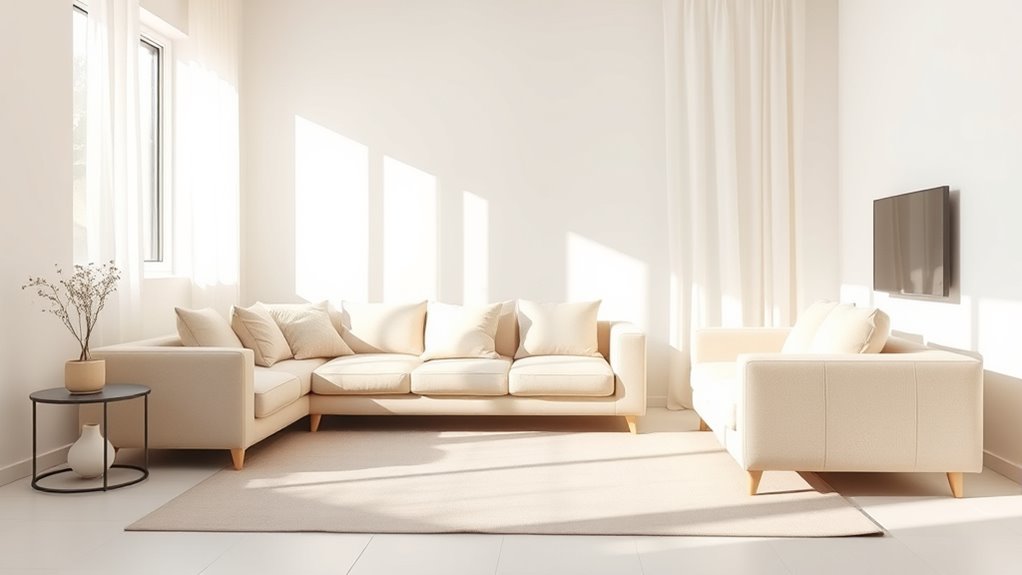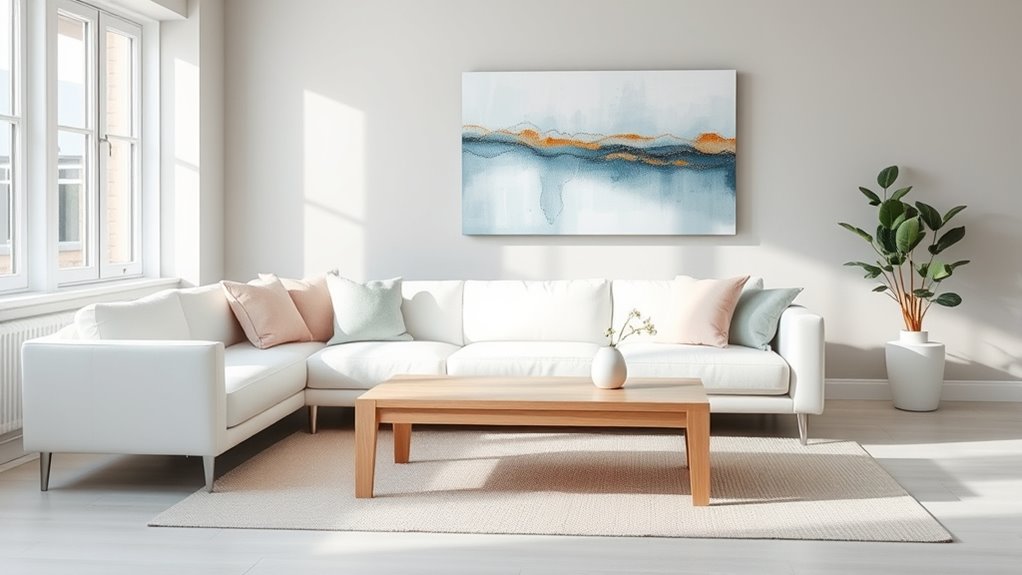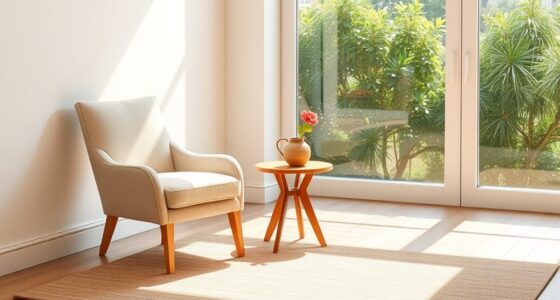Choosing the right color palette is essential in a minimalist home because it sets the overall mood, making your space feel calm and cohesive. Neutral and subtle shades create a tranquil backdrop that highlights natural accents and textures, while accent walls add visual interest without clutter. Your color choices influence how open or cozy your space feels, shaping a peaceful atmosphere. To discover how color can truly transform your minimalist haven, continue exploring these design principles.
Key Takeaways
- Establish a calm, cohesive environment that enhances tranquility and simplicity within the space.
- Use neutral and subtle shades to highlight natural textures and create a serene backdrop.
- Incorporate accent walls to add visual interest without cluttering the minimalist aesthetic.
- Influence the room’s atmosphere, making spaces feel larger, open, and inviting through strategic color choices.
- Define the overall aesthetic and emotional tone, reflecting a balanced, peaceful lifestyle.

In a minimalist home, choosing the right color palette is essential to creating a serene and cohesive space. The colors you select set the tone and influence how you feel within your environment. A well-thought-out palette helps unify different areas, making the space feel more open and balanced. When aiming for simplicity, subtle and neutral shades often work best, as they create a calm backdrop that allows natural accents to shine. These accents—such as wooden furniture, woven baskets, or stone decor—add warmth and texture without overwhelming the minimalist aesthetic. Incorporating natural accents through your color choices also brings a sense of the outdoors inside, enhancing tranquility and grounding your space.
Choosing subtle, neutral colors creates a calm, cohesive minimalist space that highlights natural accents and enhances tranquility.
One effective way to introduce visual interest without clutter is through accent walls. An accent wall in a soft, muted tone can serve as a focal point, drawing the eye without disrupting the room’s harmony. For example, a light gray or beige wall can anchor the space, providing contrast against white or off-white walls while maintaining a minimalist vibe. This technique allows you to play with color subtly, giving your home character without sacrificing its simplicity. When selecting an accent wall color, keep in mind that it should complement the existing neutral palette and enhance natural accents. This approach creates a cohesive look that feels intentional and thoughtfully designed.
Color palettes in a minimalist home aren’t just about aesthetics—they also influence the atmosphere. Light, airy hues like whites, creams, and soft grays promote openness and calm. These shades reflect natural light, making your space feel larger and more inviting. To add depth and richness, you can incorporate darker neutrals or earthy tones in small doses, such as through textiles or artwork. Natural accents work perfectly with these hues, reinforcing the organic, unpretentious vibe of minimalist design. Additionally, understanding Tiny House Designs can help you optimize small spaces with thoughtful color choices that maximize perceived size and comfort. When you choose your color palette carefully, you create a harmonious environment that invites relaxation and clarity.
Ultimately, color choices are your foundation for a cohesive, peaceful minimalist home. They help you highlight natural accents and create focal points without clutter. Whether through a subtle accent wall or a neutral background enhanced by natural textures, your color palette shapes the entire atmosphere. When you’re intentional about your color decisions, your space not only looks beautiful but also feels like an extension of your calm, collected lifestyle. In the end, the right palette doesn’t just decorate your home—it defines its soul.
Frequently Asked Questions
How Do Color Palettes Influence Room Perception in Minimalism?
Color palettes greatly influence how you perceive a room in minimalism. They create color harmony, making the space feel cohesive and calming. A well-chosen palette guides your eye smoothly, establishing visual flow that emphasizes simplicity. When you select harmonious colors, you enhance the room’s openness and serenity, making it appear larger and more inviting. Ultimately, thoughtful color palettes shape your experience, highlighting minimalist beauty through balanced, intentional design.
Can Bold Colors Work in a Minimalist Home?
You might think bold colors clash with minimalism, but they can work beautifully if used as bold accents. By maintaining color consistency and choosing one statement hue, you create focal points without overwhelming the space. Incorporate bold accents through accessories or furniture, ensuring your overall palette remains simple. This approach adds personality and visual interest while preserving the clean, uncluttered feel that’s essential in a minimalist home.
How to Choose a Color Palette for Small Spaces?
When choosing a color palette for small spaces, consider color psychology to create the desired mood. Opt for light, neutral shades to make the area feel more open and airy. Use paint finishes like matte or eggshell to add subtle texture without overwhelming the space. You should also incorporate a few bold accents sparingly to add personality while maintaining a minimalist vibe. This approach makes your small space feel larger and inviting.
What Are Common Color Mistakes in Minimalist Design?
Think of your minimalist space as a delicate balance beam—you don’t want to tip it. Common mistakes include color clash, where bold hues collide, and overusing neutrals, which can make rooms feel dull and lifeless. You might also fall into the trap of too many shades competing for attention. Keep your palette simple and harmonious, avoiding these pitfalls to create a calm, cohesive environment that feels just right.
How Do Color Palettes Affect Mood and Atmosphere?
Color palettes directly influence your mood and atmosphere through their psychological impact. By choosing calming neutrals or soft pastels, you create a serene, inviting space that promotes relaxation. Conversely, bold hues can energize or stimulate. Color psychology guides you to select shades that reflect your desired vibe, making your minimalist home feel balanced, harmonious, and tailored to your emotional needs. Your choices shape the overall ambiance effortlessly.
Conclusion
Think of your minimalist home as a blank canvas awaiting your unique story. The color palette is the brushstroke that brings life, mood, and personality to your space. Just as a painter chooses their colors carefully, you shape your environment with intention. When your colors harmonize, they create a symphony of calm and clarity. In this way, your palette becomes the silent narrator of your everyday moments, turning simplicity into a vibrant, meaningful masterpiece.









